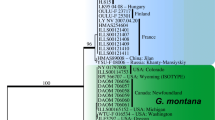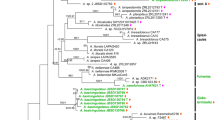Abstract
Taxa in the Gyromitra gigas species complex were previously studied and their taxonomy resolved. During ongoing studies in this group, cryptic speciation was discovered in G. gigas. Sequences of the ITS and LSU regions from 75 specimens were included in maximum likelihood and Bayesian phylogenetic analyses to establish species boundaries and resolve species relationships. Sequence similarity comparisons were also conducted between the two ribosomal markers and between the ITS1 and ITS2 regions. Gyromitra gigas sensu stricto and two additional species were discovered within the G. gigas clade. Gyromitra ussuriensis was rediscovered as a distinct taxon and removed from synonymy under G. gigas. It occurs in central and eastern Asia, whereas G. gigas occurs mostly in Europe but also extends into central Asia. A neotype is designated for G. ussuriensis. A new species, Gyromitra americanigigas, is described and illustrated from eastern North America. Although morphology and the LSU exhibited little variation among the three species, the ITS1 and ITS2 regions displayed similar interspecific sequence variability around 0.5–1%, which is sufficient for species identification at the molecular level.




Similar content being viewed by others
Data availability
All data and materials have been deposited in publicly accessible holdings.
References
Abarenkov K, Tedersoo L, Nilsson RH, Vellak K, Saar I, Veldre V, Parmasto E, Prous M, Aan A, Ots M, Kurina O, Ostonen I, Jõgeva J, Halapuu S, Põldmaa K, Toots M, Truu J, Larsson KH, Kõljalg U (2010) PlutoF—a web based workbench for ecological and taxonomic research, with an online implementation for fungal ITS sequences. Evol Bioinform Online 6:189–196. https://doi.org/10.4137/EBO.S6271
Alfaro ME, Zoller S, Lutzoni F (2003) Bayes or bootstrap. A simulation study comparing the performance of Bayesian Markov chain Monte Carlo sampling and bootstrapping in assessing phylogenetic confidence. Mol Biol Evol 20:255–266. https://doi.org/10.1093/molbev/msg028
Carbone M, Van Vooren N, Klener V, Alvarado P (2018) Preliminary phylogenetic and morphological studies in the Gyromitra gigas lineage (Pezizales): Epitypification of Gyromitra gigas and G. ticiniana. Ascomycete.org 10(5):187–199. https://doi.org/10.25664/art-0241
Darriba D, Taboada GL, Doallo R, Posada D (2012) jModelTest 2: more models, new heuristics and parallel computing. Nat Methods 9:772. https://doi.org/10.1038/nmeth.2109
Gouy M, Guindon S, Gascuel O (2010) SeaView version 4: a multiplatform graphical user interface for sequence alignment and phylogenetic tree building. Mol Biol Evol 27:221–224. https://doi.org/10.1093/molbev/msp259
Guindon S, Gascuel O (2003) A simple, fast and accurate algorithm to estimate large phylogenies by maximum likelihood. Syst Biol 52:696–704. https://doi.org/10.1080/10635150390235520
Hasegawa M, Kishino H, Yano T (1985) Dating of the human-ape splitting by a molecular clock of mitochondrial DNA. J Mol Evol 22:160–174. https://doi.org/10.1007/BF02101694
Healy RA, Arnold AE, Bonito G, Huang YL, Lemmond B, Pfister DH, Smith ME (2022) Endophytism and endolichenism in Pezizomycetes: the exception or the rule? New Phytol 233:1974–1983
Hillis DM, Bull JJ (1993) An empirical test of bootstrapping as a method for assessing confidence in phylogenetic analysis. Syst Biol 42:182–192. https://doi.org/10.1093/sysbio/42.2.182
Huelsenbeck JP, Ronquist FR (2001) MrBayes: Bayesian inference of phylogenetic trees. Bioinformatics 17:754–755. https://doi.org/10.1093/bioinformatics/17.8.754
Huelsenbeck JP, Ronquist FR (2005) Bayesian analysis of molecular evolution using MrBayes. In: Nielsen R (ed) Statistical methods in molecular ecology. Springer Publishing Co, New York, pp 186–226
Krisai-Greilhuber I, Chen Y, Jabeen S, Madrid H, Marincowitz S, Razaq A, Ševčíková H, Voglmayr H, Yazici K, Aptroot A, Aslan A, Boekhout T, Borovička J, Crous PW, Ilyas S, Jami F, Jiang Y-L., Khalid AN, Kolecka A, Konvalinková T, Norphanphoun C, Shaheen S, Wang Y, Wingfield MJ, Wu S-P, Wu Y-M, Yu J-Y (2017) Fungal systematics and evolution: FUSE 3. Sydowia 69:229–264. https://doi.org/10.12905/0380.sydowia69-2017-0229
Larget B, Simon DL (1999) Markov Chain Monte Carlo algorithms for the Bayesian analysis of phylogenetic trees. Mol Biol Evol 16(6):750–759. https://doi.org/10.1093/oxfordjournals.molbev.a026160
Lücking R, Aime MC, Robbertse B, Miller AN, Ariyawansa H, Aoki T, Cardinali G, Crous P, Druzhinina I, Geiser D, Hawksworth D, Hyde K, Irinyi L, Jeewon R, Johnston P, Kirk P, Malosso E, May T, Meyer W et al (2020) Unambiguous identification of fungi: where do we stand and how accurate and precise is fungal DNA barcoding? IMA Fungus 11:1–32
Matute DR, Sepúlveda VE (2019) Fungal species boundaries in the genomics era. Fungal Genet Biol 131:1–9
McKnight KH (1971) On two species of False Morels (Gyromitra) in Utah. Great Basin Naturalist 31(2):35–47
Miller MA, Pfeiffer W, Schwartz T (2010) Creating the CIPRES Science Gateway for inference of large phylogenetic trees. In: Proceedings of the Gateway Computing Environments Workshop (GCE), 14 Nov 2010, New Orleans, Louisiana, pp 1–8
Miller AN, Yoon A, Gulden G, Stensholt Ø, Van Vooren N, Ohenoja E, Methven AS (2020) Studies in Gyromitra I: the Gyromitra gigas species complex. Mycol Progress 19:1459–1473. https://doi.org/10.1007/s11557-020-01639-8
Miller AN, Karakehian J, Raudabaugh DB (2022) Next generation sequencing of ancient and recent fungarium specimens. J Fungi. (in press)
MyCoPortal (2022) http://mycoportal.org/portal/index.php. Accessed on March 10
Posada D, Buckley TR (2004) Model selection and model averaging in phylogenetics: advantages of Akaike information criterion and Bayesian approaches over likelihood ratio tests. Syst Biol 53:793–808. https://doi.org/10.1080/10635150490522304
Raitviir A (1970) Once more on Neogyromitra caroliniana. Botaanika-alased tõõd 9:364–373
Stamatakis A (2014) RAxML version 8: a tool for phylogenetic analysis and post-analysis of large phylogenies. Bioinformatics 30(9):1312–1313. https://doi.org/10.1093/bioinformatics/btu033
Stamatakis A, Hoover P, Rougemont J (2008) A fast bootstrapping algorithm for the RAxML web-servers. Syst Biol 57:758–771. https://doi.org/10.1080/10635150802429642
Swofford DL (2002) PAUP*. Phylogenetic analysis using parsimony (*and other methods). Version 4. Sinauer Associates, Sunderland, Massachusetts
Thiers B (2013) Index Herbariorum: a global directory of public herbaria and associated staff. New York Botanical Garde’s Virtual Herbarium. http://sweetgum.nybg.org/ih
Van Vooren N, Moreau P-A (2009) Essai taxinomique sur le genre Gyromitra Fr. sensu lato (Pezizales). 3. Le genre Gyromitra Fr., sous-genre Discina. Ascomycete.org 1(2):3–13. https://doi.org/10.25664/art-0003
Vassiljeva LN (1950) Species novae fungorum. Notulae Systematicae e Sectione Cryptogamica Instituti Botanici Nomine V.L. Komarovii Academiae Scientificae USSR. 6:188–200
Wang X-C, Zhuang W-Y (2019) A three-locus phylogeny of Gyromitra (Discinaceae, Pezizales) and discovery of two cryptic species. Mycologia 111(1):69–77. https://doi.org/10.1080/00275514.2018.1515456
Acknowledgements
The authors wish to thank the curators and collection managers for the loan of specimens at the following fungaria: BPI, CUP, F, ILLS, LE, MICH, MIN, NY, O, TAAM, TNS, and YSU. Yuri Roskov at the University of Illinois is thanked for the translation of Russian text. Sanger sequencing was performed at the Roy J. Carver Biotechnology Center at the University of Illinois.
Author information
Authors and Affiliations
Contributions
ANM was responsible for the study conception and design. ANM, AD, and EP generated molecular sequence data. AD, EP, and NF provided voucher specimens. Molecular analyses were performed by ANM. Morphological analyses were performed by ASM. The first draft of the manuscript was written by ANM, ASM edited the manuscript, and all authors commented on subsequent versions of the manuscript. All authors read and approved the final manuscript.
Corresponding author
Ethics declarations
Ethics approval
Not applicable.
Consent to participate
Not applicable.
Consent for publication
Not applicable.
Conflict of interest
The authors declare no competing interests.
Additional information
Section Editor: Roland Kirschner
Publisher’s note
Springer Nature remains neutral with regard to jurisdictional claims in published maps and institutional affiliations.
Rights and permissions
Springer Nature or its licensor holds exclusive rights to this article under a publishing agreement with the author(s) or other rightsholder(s); author self-archiving of the accepted manuscript version of this article is solely governed by the terms of such publishing agreement and applicable law.
About this article
Cite this article
Miller, A.N., Dirks, A.C., Filippova, N. et al. Studies in Gyromitra II: cryptic speciation in the Gyromitra gigas species complex; rediscovery of G. ussuriensis and G. americanigigas sp. nov.. Mycol Progress 21, 81 (2022). https://doi.org/10.1007/s11557-022-01832-x
Received:
Revised:
Accepted:
Published:
DOI: https://doi.org/10.1007/s11557-022-01832-x




